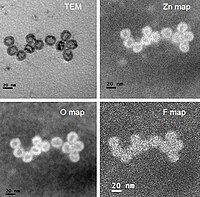
Photo from wikipedia
Indium (0.01, 0.04 and 0.06 mol%) doped ZnO nanoparticles (IZ-NPs) have been synthesized using the facile co-precipitation method. The prepared nanoparticles (NPs) were characterized by X-ray diffraction (XRD), scanning electron microscopy… Click to show full abstract
Indium (0.01, 0.04 and 0.06 mol%) doped ZnO nanoparticles (IZ-NPs) have been synthesized using the facile co-precipitation method. The prepared nanoparticles (NPs) were characterized by X-ray diffraction (XRD), scanning electron microscopy (SEM), Elemental dispersive spectroscopy (EDS), UV–Vis absorption spectrum (UV–Vis) and photoluminescence (PL) techniques. The photocatalytic activities were evaluated for the degradation of Rhodamine-B (Rh-B) under UV–Vis irradiation. The antibacterial properties of Zinc oxide nanoparticles (NPs) were investigated using human pathogens and were compared based on the diameter of inhibition zone using Agar-well diffusion method. Structural studies confirm the main presence of hexagonal wurtzite ZnO phase and well-crystalline. The incorporation of indium ions was responsible for the change in their various lattice parameters. The average crystallite sizes were decreased by increasing the indium dopant concentration. SEM images reveal the synthesized NPs are in nanometer range with various shape and improved crystallinity is noted for higher doping (In) concentration. The presence of indium in the host lattice was confirmed by EDS spectroscopy. Optical studies shows that the band-gap energy decreases (3.34–3.17) with an increase in doping concentration (2–6%). The photoluminescence (PL) spectrum reveals the UV emission is strong near the band-edge region (NBE) (392 nm) and intrinsic defects encountered in series of visible emission peaks around 400–560 nm. From the efficiency of the photocatalytic activity, higher dopant concentration (6%) showed higher photocatalytic activity than the other NPs in destroying Rhodamine B (RhB) under UV–Vis light irradiation. The synthesized In-doped Zinc oxide nanostructures show maximum antibacterial activity against Staphylococcus aureus and Staphylococcus epidermidis.
Journal Title: Journal of Materials Science: Materials in Electronics
Year Published: 2017
Link to full text (if available)
Share on Social Media: Sign Up to like & get
recommendations!